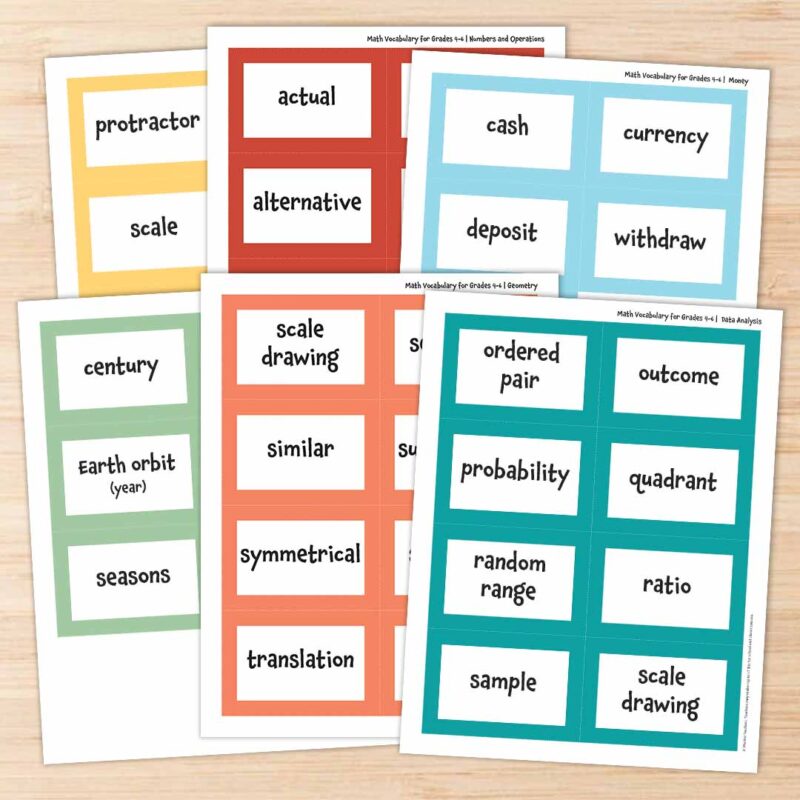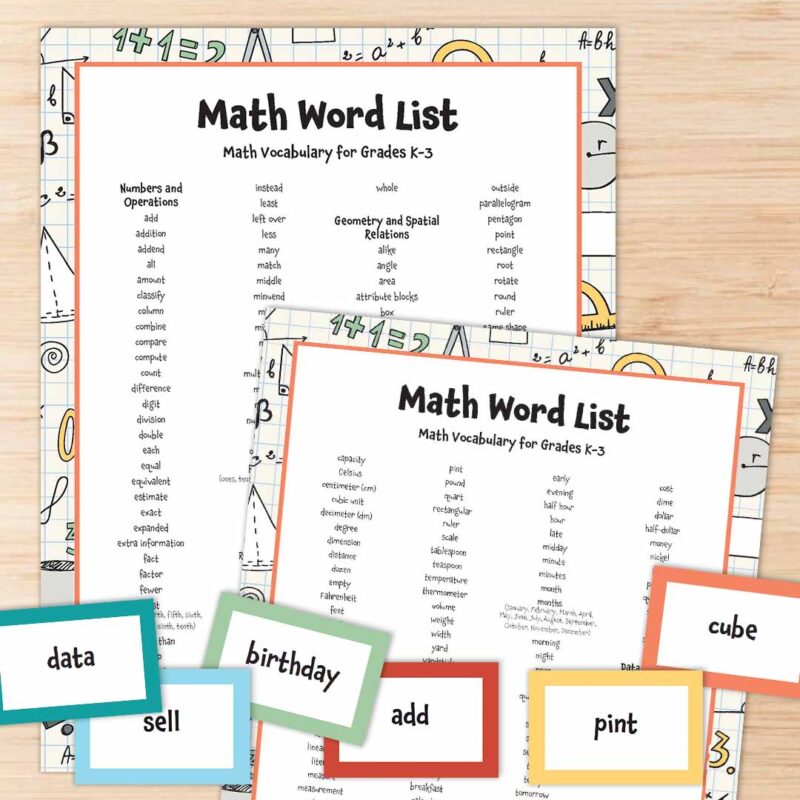Math Words (Vocabulary List, Teaching Ideas, and Free Printables)

So much of math teaching is actually language teaching as well. There are quite a few math vocabulary words kids must understand in order to learn math concepts. It’s like a whole other language! That’s where these free printable math vocabulary lists and cards come in handy.
There are two lists: one for grades K-3 and one for grades 4-6. Each set of words is organized by concept strand and then alphabetized for easy use. There will be some overlap and you may find, depending on your class, that you will use words from both lists.
The printable cards are great for creating a word wall and for a variety of learning activities. As you introduce a concept, consider adding each new vocabulary word to the word wall. In fact, some teachers like to add pictures or examples to the word wall. You could do this or invite students to take turns helping to “manage” and “enhance” the word wall. Then use the cards for some of the activities below to engage and excite students about learning the “language of math.”
Jump to:
Math Vocabulary for Grades K-3
Math Vocabulary for Grades 4-6
Activities Using Math Word Lists and Cards
Math Vocabulary for Grades K-3
Numbers and Operations
add, addition, addend, all, amount
classify, column, combine, compare, compute, count
difference, digit, division, double
each, equal, equivalent, estimate, exact, expanded, extra information
fact, factor, fewer, first (second, third, fourth, fifth, sixth, seventh, eighth, ninth, tenth)
greater than, group
hundred
identify, increase, instead
least, left over, less
many, match, middle, minuend, minus, missing, model, more, multiplication, multiply
number, number line, numeral
operations
place value (ones, tens, hundreds, thousands), plus, product
regroup, related facts, Roman numerals, rounding
same, sign, skip-count, solve, subtract, subtraction, sum
total
whole
Geometry and Spatial Relations
alike, angle, area, attribute blocks
box
center, circle, closed, cone, congruent, connect, construct, corner, corresponding, cube, curve, curved, cylinder
edge, end point
face, figure, flat, flip
geometry
hexagon, horizontal
inside
on, open, outside
parallelogram, pentagon, point
rectangle, root, rotate, round, ruler
same shape, same size, segment, side, size, solid, sphere, square, stairs, straight, symmetry (line of symmetry)
tessellation, tile, tilt, triangle, tube, turn
vertical
whole, width
Measurement
apart, area
capacity, Celsius, centimeter (cm), cubic unit
decimeter (dm), degree, dimension, distance, dozen
empty
Fahrenheit, feet, foot
gallon (gal), gram (g)
height
inch
kilogram (kg), kiloliter (kl), kilometer (km)
length, linear unit, liter (l)
measure, measurement, meter (m), meter stick, metric unit, mile, milligram (mg), milliliter (ml), millimeter (mm)
ounce (oz)
perimeter, pint, pound
quart
rectangular, ruler
scale
tablespoon, teaspoon, temperature, thermometer
volume
weight, width
yard, yardstick
Time
after, afternoon, a.m., analog
before, birthday, breakfast
calendar, clock (long hand, short hand)
daily, date, days, days of the week (Monday, Tuesday, Wednesday, Thursday, Friday, Saturday, Sunday), digital
early, evening
half hour, hour
late
midday, minute, minutes, month, months (January, February, March, April, May, June, July, August, September, October, November, December), morning
night, noon
p.m.
quarter hour
season, seasons, second, seconds
time, today, tomorrow, tonight
watch, week
year, yesterday
Money
buy
cent, change, cost
dime, dollar
half-dollar
money
nickel
pay, penny
quarter
save, sell, spend
Data Analysis
average
bar graph
data
grid
picture graph
Math Vocabulary for Grades 4-6
Numbers and Operations
actual, adjacent, alternative, approximately, array, associative property, at least, at most
calculate, cardinal, common multiple, composite number
decimal, decimal point, determine, distributive property, dividend, divisor
extrapolate
factor
geometric pattern
if … then, infinite set, insufficient information
magic square, member, multiple, multiplication, multiplier
natural number, natural order
place value, prime, prime factorization, problem, product, property, proportion
quotient
ratio, remainder, repeating decimal, rule
score, statement
terminate, times
value
Geometry
altitude, angle (acute, obtuse, right), arc, axis
base
circle (center, diameter, radius, semicircle), compass, construction, coordinates
diagonal, diagram
hemisphere
image, intersect
line, line of symmetry, line segment
parallel, perimeter, perpendicular, pi, plane, polygon, population density, prism (square, triangular), pyramid (square, triangular)
quadrilateral (kite, rhombus, parallelogram)
radius, ray, reallotment, reflections, rotations (half-turn, quarter-turn)
scale drawing, semicircle, similar, surface area, symmetrical, symmetry
translation, trapezoid, triangle (equilateral, right, isosceles, scalene)
vertex, view (front, side, top)
Measurement
capacity
decade
estimate
gallon (gal), graduated, gross
ounce (oz)
perimeter, protractor
quart
scale, square foot, square inch, square meter, square mile
ton
Time
century
Earth rotation (day), Earth orbit (year)
month (moon)
seasons
yearly
Money
cash, currency
deposit
withdraw, withdrawal
Data Analysis
broken-line graph
descriptive statistics
equally likely events
factor tree, frequency
generalization
histogram
inference, interpolate, interpret
line graph, line plot
mean, median, midway, mode
ordered pair, outcome
probability
quadrant
random range, ratio
sample, scale drawing, simple event, statistics
Activities Using the Math Word List and Cards

What Is It?
Give each student a white board or a piece of paper and something to write with. As you introduce a word, for example “square,” hold up the vocabulary card and ask, “What is this? Can you draw it or write an example?” You can use almost any words, such as addition equation, two-digit number, quadrilateral, sum, and so on.
Some words might require more words, numbers, and/or drawings. Make sure students understand by doing a couple of examples. After you ask the question and show the word card, take a walk around to look at and have students share their responses.
Math Word Concentration
Using index cards, write a vocabulary word on one and on another an example or picture. On the back of each pair, write the same number. Make at least 10 pairs depending on the concept you are working on.
Mix the cards up and put them face down on a table or floor with a dividing line between words on one side and examples on the other (a piece of yarn works well here). Have students take turns flipping two cards over trying to find a match of word card and example card. You can play as individuals or teams.
It’s a lot of fun and a great learning experience to have students make their own card sets to share with the class.
Math Clue Cards
Using the cards created for Concentration (see above), choose a word card and describe or give clues to the targeted word. For example, for the word “square,” you might say, “It has four sides, all four sides are straight, all four sides are of equal length.” Demonstrate this a few times, and then let students take turns picking cards and supplying clues.
Can You Use It in a Sentence?
Using the Concentration cards again, put the cards in a stack, face down. Have a student turn over the top card and use the word in a sentence that demonstrates understanding. For example, let’s say a student picks the word “Add.” An acceptable sentence that shows understanding could be, “When I add 2 + 2, I get a sum of 4.” An unacceptable answer, one that doesn’t show understanding, would be, “I like to add.” Give these as examples so everyone understands the criteria for a good answer.
You can play this as a class, small group, or partners.
Math Word Bingo
Prepare bingo cards or sheets with the math vocabulary words you want students to practice. For younger students, a bingo card with eight spaces is a good start. For older students, the card can have up to 25 spaces (with a “Free Space” in the center).
There are a few ways to play. You could start by having a helper student pick a card from a pile and read it out loud. Players mark that square with whatever token you’d like to use. Once they have a row or column filled in, they call out, “Math Bingo!”
Another way to play is to call out a definition or example and have players hunt for the math vocabulary word that matches the example. You could also reverse that by preparing cards with examples and having helpers call out the vocabulary words. There are lots of ways to have fun with this game!
Get Your Free Math Vocabulary Word Printables

Print copies of the word list and cards to keep on hand for word walls, teaching examples, and for games and activities like the ones described above.
Plus, find a treasure trove of math articles on our Math Topics page!
Source link




